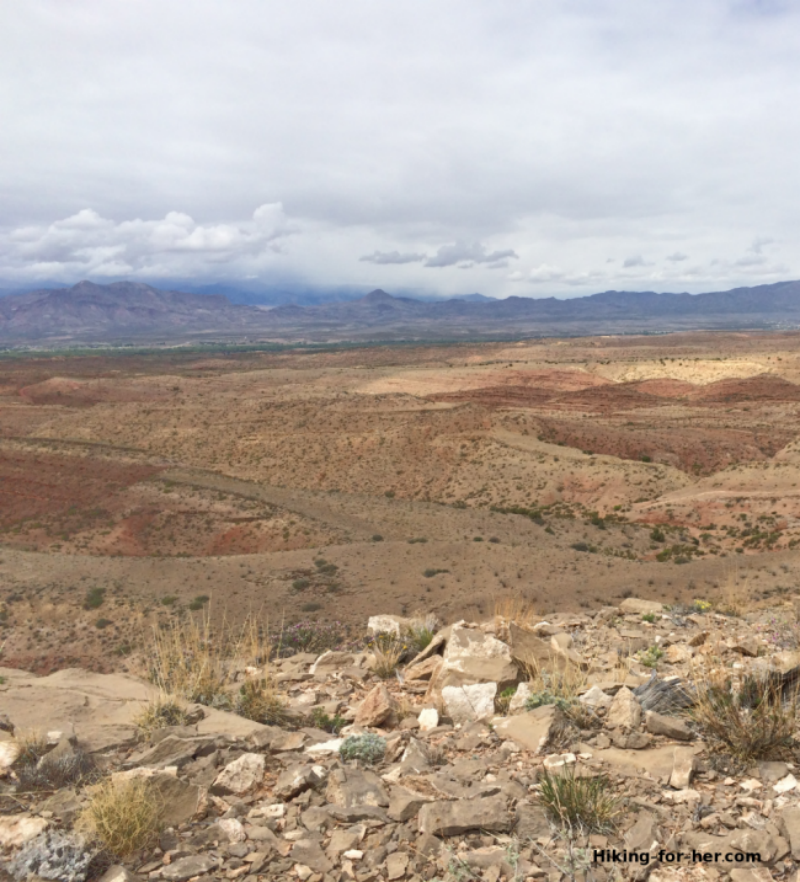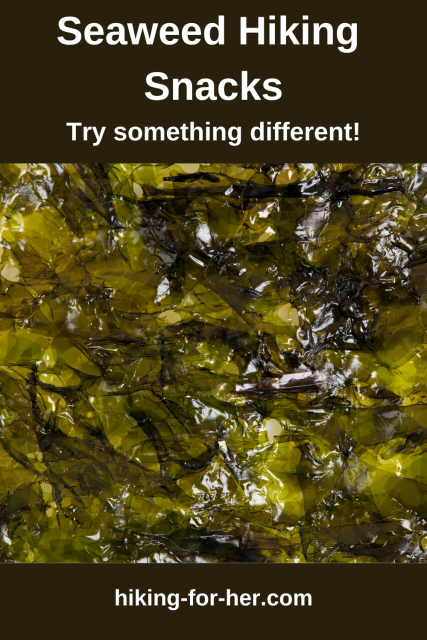
Seaweed Hiking Snacks -
Ready For Something
A Little Different?
By Diane Spicer
Seaweed hiking snacks?
Am I trying to mess with you?
Nah! Just trying to help.
I know that you’re probably comfortable with granola, trail mix, crackers and energy bars as recommended hiking snacks.
- In fact, I consume, and recommend, these hiking staples myself.
But today, let’s blow that stereotypical approach to trail food right out of the water, using something tasty from the waters of our planet: seaweed
A rose by any other name?
First of all, let’s substitute the proper name for this gift from Mother Nature’s vast salty waters: sea vegetables.
Sounds better already, doesn’t it!
There are a variety of edible sea vegetables, as humans around the globe already know.
As hikers, let’s focus on four of them (drop down for the details with these links):
Wait! Why bother with
seaweed hiking snacks?
If you’re comfortable with granola and energy bars, what's the motivation to add sea vegetable snacks to your hiking menu?
Two good physiological reasons: salts and iodine.
Salts are vital
Sea water and your blood have the same salty composition.
Eating sea veggie snacks is an easy way to return salt to your bloodstream, for delivery to your hard working cells.
Cells use the salts (sodium, chloride, potassium) for vital electrical activity, which includes opening and closing membrane pores, muscle contractions, and brain activity.
Sounds like important work for a hiker's body, right?
Don't forget about iodine!
And then there’s iodine.
Sea vegetables are bursting with it.
While you don’t need iodine directly for fueling your muscle
contractions as you hike, your thyroid uses it to build important hormones directly related to your overall performance as an endurance athlete.
Your thyroid is like the throttle on an engine: it regulates how fast you consume fuel.
- An under performing thyroid robs you of that
energetic “pep in your step” feeling.
- An over performing thyroid makes you jittery and unfocused on the trail.
And as women, we are prone to thyroid problems (often undiagnosed), so enjoying a seaweed snack is a low cost health "insurance policy".
- Sea vegetables are an easy way to get iodine atoms into your bloodstream, where your thyroid can upload them and then sort out what to do with them.
Fair warning
You already expect these snacks to be salty. That’s the whole point of eating them!
But unless you already appreciate Japanese and Korean cuisine, sea vegetable snacks can be an acquired taste.
- You know how the ocean smells? That’s how these snacks taste (the only way I can describe it).
Here’s your chance to be a bit more adventurous in your hiking snack selection.
But fair warning: Don’t pack them for your hiking lunch without
trying them on several occasions at home.
And don’t
give up if you don’t like the first brand you try. Sometimes it takes more than one exposure to a new food to truly appreciate it.
You may learn to appreciate umami, the savory taste among your five taste senses, which is a combination of many factors.
- The type of sea weed, and the process used for drying, will affect your taste bud perceptions.
One other cautionary note: Be careful to select products which come from unpolluted ocean waters.You want to ingest only good stuff!
Seaweed hiking snacks for day hikes
I know you get tired on the trail, but do you ever experience taste bud fatigue on a hike?
Sea vegetable snacking will shake you out of your complacency.
- They offer new smells, textures and taste sensations.
- They hit the spot when you crave salt on a warm hiking trail.
- And the crunch makes them seem like you're eating something special - almost forbidden!
Want to really wake up your taste buds?
- Pack these chili lime seaweed sheets in your lunch sack - yum!
Another approach: Rice crackers wrapped in nori. I can't get enough of these things!
- Purchasing a large bag makes it easy to bag small individual servings and to enforce portion control (speaking strictly for myself, of course).
- This hiking snack delivers simple carbohydrates for energy PLUS the salts and iodine noted above.
That's a solid win-win for hiking energy and endurance, especially in dry, hot conditions.
Speaking of hot and dry, here are some other tips for these conditions.
 Far away from the sea, but enjoy seaweed snacks here anyway!
Far away from the sea, but enjoy seaweed snacks here anyway!
Seaweed hiking snacks and menu ideas
for backpackers
Backpacking really takes a toll on your body.
Sea veggies can help reverse it, by supplying nutrients for cellular repair and optimal functioning.
And you can fine tune this process by selecting the right sea veggies to add to your hiking menu, depending on your chronic backpacking issues.
Are you new to the wonderful world of backpacking food?
- Get up to speed fast here.
Carry kombu
Backpackers should bring along some dried, ground up kombu for two reasons.
This sea veggie contains glutamic acid, which can reduce the gassy effect of eating beans (and most backpackers rely on beans for at least a few dinners).
Kombu also imparts flavor to broth, meaning it can perk up any soup or a heaping bowl of quinoa.
- In fact, it’s likened to savory chicken stock in some Japanese kitchens!
Tip: Soup is an easy way to re-hydrate after a long day. Make it part of your pre-dinner ritual as your main entrée is being prepared.
Wakame works wonders
Speaking of soups, wakame can be combined with miso paste for a tasty, healthy cup of something hot while you set up camp.
Wakame also provides calcium and magnesium, which are important for your next day’s muscle contractions.
- If you’re prone to muscle cramps at night, try some as a warm nightcap before crawling into your tent.
Arame to the rescue!
Arame is the sea vegetable to bring along for maximum potassium benefits.
If you experience muscle cramping after a day or two of backpacking, why not add some re-hydrated arame to a cooked grain?
- It has a sweet taste that pairs well with quinoa and rice, especially with some plumped up rehydrated veggies over the top.
Nori noshing
Nori is the “seaweed” you’ve seen offered as paper thin sheets.
You can use it to roll up the rice you cooked up for dinner, and appreciate the fact that you’re now eating a meal high in protein along with your starches.
Nori delivers a nice dose of vitamin B12, important for optimal nerve function.
- And if you’re a strict vegetarian, every source of B12 counts, whether you're on the trail or at home.
What do you think about
seaweed hiking snacks now?
You have your favorite trail food, so it’s not my intention to mess with what’s working for you.
But why not consider this as gentle encouragement to try something a little different in your hiking snack repertoire?
Start off with a few nibbles, and before you know it, you'll be carving the salty, indescribably goodness of seaweed hiking snacks.
Ready for more nitty gritty hiking nutrition tips?
- I've gotcha covered right here!
Home page > Trail Snacks > Seaweed Hiking Snacks
|
I get emails all the time about what I wear, eat, carry and love to use on the trail. That's
why I provide affiliate links to you: the best gear that I use myself and have seen used by other hikers is instantly
available for your consideration, and the gear company sends a few
pennies per dollar to this reader-supported hiking website. There is no added cost to you! Everyone ends up a winner: Great gear for you, strong gear companies, and more free hiking tips for everyone. Thanks very much for your support. It's warmly and sincerely appreciated. It also helps send these hiking tips to all your virtual trail buddies around the globe. |
 |


